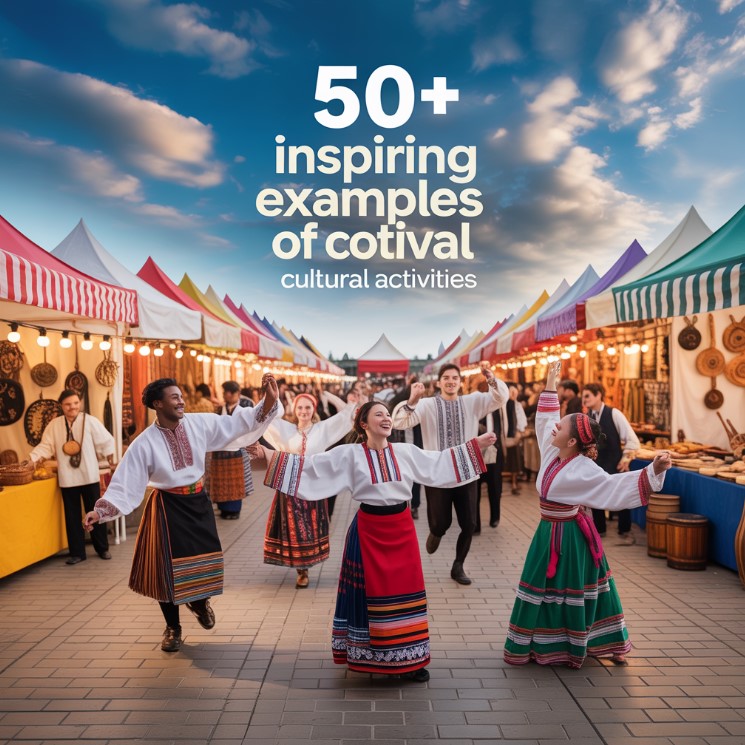50+ Inspiring Examples of Cultural Activities

Contents
What exactly are cultural activities? Far more than just a trip to a museum, they are the living, breathing expressions of a community’s heritage, values, and traditions. Engaging in these activities connects us to our own roots, builds empathy for others, and deeply enriches our lives.
Whether you’re an educator planning a lesson, a parent looking for a meaningful family outing, or simply a curious individual eager to explore, this list is for you. Here are over 50 inspiring examples of cultural experiences you can explore, conveniently organized into categories.
I. At Home & Personal Pursuits
These cultural activities are perfect for exploring on your own time, right from the comfort of your home.
- Cook a Traditional Dish: Connect with a culture through its flavors. Ask a relative for a family recipe or find an authentic tutorial online for a dish you’ve never tried.
- Learn a New Language: Use apps like Duolingo or Babbel to learn basic phrases. This opens a doorway to understanding a new way of thinking and communicating.
- Watch a Foreign Film with Subtitles: Experience storytelling from a different perspective. Watching with subtitles (instead of dubbing) allows you to hear the language’s natural rhythm and emotion.
- Read Literature from Another Country: Pick up a translated novel or a collection of poetry. Literature offers deep insights into a society’s values, history, and a-day-to-day life.
- Trace Your Family Tree: Use genealogy websites or talk to older relatives to map out your ancestry. This is a powerful heritage activity that connects you directly to your own past.
- Learn a Traditional Craft: Try knitting, origami, calligraphy, or pottery through online workshops. These creative pursuits are often steeped in centuries of tradition.
- Listen to World Music: Create a playlist featuring music from a specific region or genre you’re unfamiliar with, from Celtic folk to Brazilian Bossa Nova.
- Explore a Virtual Museum Tour: Many world-famous museums, like the Louvre or The British Museum, offer incredible virtual art exhibitions you can tour from your couch.
- Celebrate a Holiday from Another Culture: Research and respectfully participate in traditions associated with a holiday like Diwali, Lunar New Year, or Hanukkah.
- Follow Cultural Bloggers or YouTubers: Find creators who share authentic insights into their daily life, food, and traditions in other parts of the world.
- Learn to Play a Traditional Instrument: Take online lessons for an instrument like the ukulele, a tin whistle, or a djembe drum.
- Study a Map: Spend time with a world map or globe. Learning the geography of a place is the first step to understanding its people.
II. In Your Local Community
Culture is all around you. These community gatherings and events are fantastic ways to engage with the diverse world in your own town.
- Attend a Local Festival: Look for a Greek, Irish, or Mexican festival in your area. These heritage celebrations are fantastic cultural experiences filled with food, music, and dance.
- Visit an Ethnic Market or Grocery Store: More than just a shopping trip, it’s a sensory experience. Discover new ingredients, hear different languages, and observe daily community life.
- Take a Community Class: Sign up for a workshop on something new, like salsa dancing, sushi making, or a language you’re interested in.
- Visit a Place of Worship (Respectfully): Attend a service at a mosque, synagogue, temple, or church different from your own. Go as an observer to learn about their traditional ceremonies and architecture.
- Eat at an Authentic Family-Owned Restaurant: Skip the chain restaurants and find a local spot. Talk to the owners about their food and where the recipes come from.
- Go to a Street Fair or Civic Event: These events often feature public programming that showcases the work of local artists, musicians, and community groups.
- Volunteer for a Cultural Organization: Offer your time at a cultural center, museum, or festival. It’s a wonderful form of community engagement.
- Attend a Local Pow Wow: If available in your area, respectfully attend a pow wow to experience the powerful drumming, dance, and artistic traditions of Indigenous peoples.
- Visit a Cultural Center: Many communities have Irish, Italian, Asian, or other cultural centers that host events, lectures, and art exhibitions.
- Join a Conversation or Language Exchange Group: Practice a new language and meet people from different backgrounds at a local library or coffee shop.
- Shop at a Craft Fair: Support local artisans and learn about the techniques and stories behind their work, from jewelry making to woodworking.
III. Arts & Performance
The arts are a universal language. Attending these artistic events is a powerful way to feel the emotional pulse of a culture.
- Visit a Museum: Go beyond the big national museums and check out smaller, specialized ones focused on local history, a specific culture, or a niche art form.
- Go to an Art Gallery Tour: See the work of local and international artists. Gallery tours often provide context that deepens your appreciation of the visual arts.
- Attend a Concert of World Music: Experience live music from a different culture. This could be anything from a classical Indian sitar performance to an electrifying Afrobeat band.
- Watch a Traditional Dance Performance: Look for dance recitals featuring styles like flamenco, Irish step dance, or classical ballet.
- See an Opera or Musical: The performing arts combine music, storytelling, and visual design to create unforgettable cultural experiences.
- Go to a Theatrical Play: See a play by a foreign playwright or one that explores cultural themes. Theatre is a window into the human condition across different societies.
- Attend a Poetry Slam or Literary Reading: Hear diverse voices and perspectives on life, identity, and community.
- Take an Art History Class: Learn about the movements, symbols, and artists that have defined different cultural eras.
- Visit an Outdoor Sculpture Garden: See how art interacts with nature and public space.
- Watch a Fashion Show: See how clothing reflects cultural identity, history, and contemporary trends.
- Attend a Film Festival: Many festivals showcase independent and international films you won’t find at the multiplex.
IV. History & Heritage
Understanding where we come from is key to understanding who we are. These activities connect us with our shared cultural heritage.
- Visit a Historical Site or Landmark: Walk the grounds of a battlefield, an ancient ruin, or a historic home to connect with the past in a tangible way.
- Participate in a Historical Reenactment: These immersive folklore events bring history to life, showing you how people lived, worked, and celebrated in the past.
- Walk Through a Historic Neighborhood: Pay attention to the architecture and street names, and imagine the stories those buildings could tell.
- Visit a National or State Park: Learn about the area’s natural history and the heritage of the Indigenous peoples who first lived there.
- Attend a Lecture at a University or Library: Many institutions offer free public lectures on history, anthropology, and world affairs.
- Read Historical Non-Fiction: Dive deep into a specific period or culture that interests you.
- Explore an Archive or Special Collection: Local libraries and historical societies often have collections of old photographs, letters, and documents.
- Visit a Cemetery: Reading old headstones can tell you a lot about a community’s history, from immigration patterns to life expectancy.
- Take a Guided Historical Tour: Let an expert guide you through your city and reveal the hidden histories you walk past every day.
- Watch a Documentary: Documentaries are an accessible and compelling way to learn about historical events and cultural figures.
- Interview an Elder: Talk to a grandparent or an older member of your community and ask them to share their life stories and memories.
- Visit a Presidential Library: These institutions are dedicated to preserving and sharing the history of a specific era in a nation’s history.
- Explore a UNESCO World Heritage Site: These sites are recognized for their outstanding cultural or natural importance to the common heritage of humanity.
- Study Traditional Folklore and Myths: Read the stories that have been passed down for generations; they reveal a culture’s deepest fears, hopes, and moral codes.
- Learn about Traditional Medicine or Healing Practices: Research how different cultures have approached health and wellness throughout history.
- Examine Old Coins or Stamps: These small artifacts are packed with cultural symbols, historical figures, and national pride.
- Contribute to a Community Archive: Help preserve local history by scanning old photos or transcribing oral histories for a historical society.
Culture is not something that is locked away in a glass case. It is a vibrant, ever-evolving part of our daily lives. By stepping outside our comfort zone and engaging in these kinds of cultural activities, we build a more connected, compassionate, and interesting world for everyone. Pick one or two ideas from this list that spark your curiosity and start exploring today.











